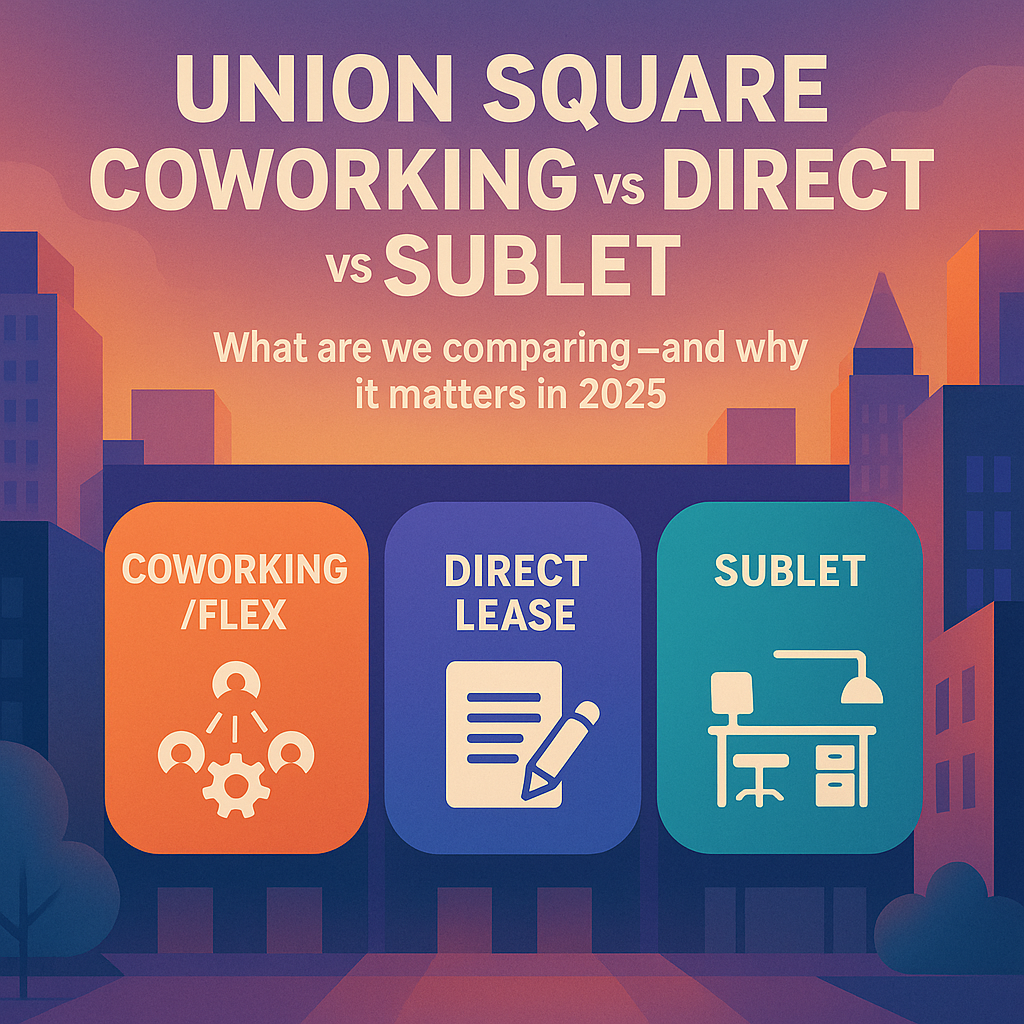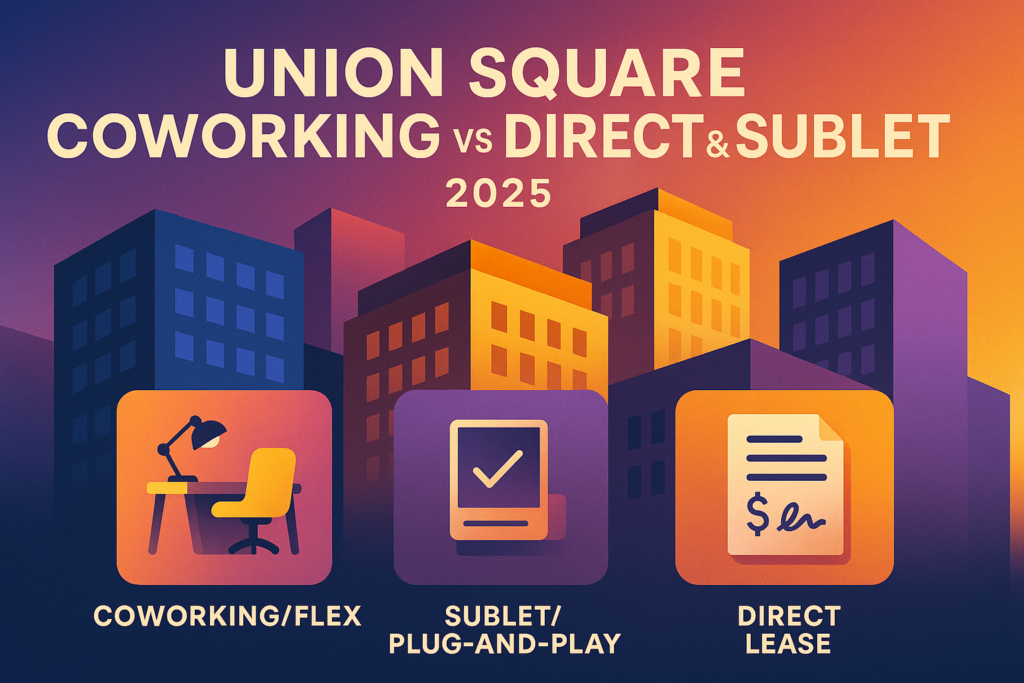Union Square Coworking vs Direct & Sublet
What are we comparing—and why it matters in 2025
Union Square offers a rare mix of multi-line transit, creative address, and value-forward buildings. In 2025, midsize teams (≈5k–20k RSF needs or ~25–150 people) usually choose among three paths:
- Coworking/Flex (shared building operations, short to mid terms, furnished, amenitized)
- Sublet/Plug-and-Play (furnished second-gen suites with remaining term)
- Direct Lease (prebuilt/spec or custom build, longer term with full concession stack)
This page evaluates which option is most competitive today for midsize tenants specifically in Union Square—where speed, budget, image, and hybrid layouts all have to fit.

Who wins where (fast orientation)
- Coworking/Flex wins when you need immediacy, shorter commitments, and variable seat counts with minimal capex.
- Sublet wins when you want furnished, private control with meaningful savings vs. face rent—plus a clear end date (12–48 months) while you plan the long term.
- Direct wins when you require brand control, predictable economics, and tailored room mixes—and can trade a longer term for front-loaded abatement, TI dollars, and early access.
The 2025 cost reality in Union Square (illustrative, not quotes)
Effective rent beats the sticker on private space
- Direct 10-year example: 120 months with 10 months free → pay 110/120 = 0.9167 of face.
- At $82/SF face, abated base ≈ $75.17/SF.
- With $110/SF TI on a 10-year term, value ≈ $11/SF/yr → economic ≈ $64.17/SF (pre-ops/taxes).
- Furnished sublease 36-month example: Face $60/SF, 2 months free → pay 34/36 = 0.9444 → $56.67/SF.
- Treat avoided FF&E as ~$4/SF/yr blended → economic ≈ $52.67/SF (pre-ops/taxes).
Coworking seat math (use your numbers)
Coworking/flex is priced per seat (or private office). For a 50-person company with 60% in-office on peak days and a 0.7 desk ratio, you might provision 35 dedicated desks/rooms plus credits for meeting rooms. If your all-in per-desk monthly run-rate (desk + fees + meeting overage) sits between your internal targets, coworking will out-compete private space in the first 12–18 months—especially if you avoid deposits, build cost, and IT set-up.
However: once you cross ~9–12 months of stable headcount at a consistent daily attendance, the per-seat premium of coworking can exceed the economic $/SF of a sublet or direct prebuilt—particularly when you leverage front-loaded free rent, TI swaps, early access, and amenity hour banks.
Where in Union Square each option shines (micro-rings you can act on)
- Near-Park East → Irving/Gramercy edge: Polished entries, strong prebuilts and managed flex suites; great for image-sensitive teams.
- Broadway/University Place (14th–18th): Boutique full floors with efficient rectangles—sublets and prebuilts that plan well for hybrid.
- Park Avenue South fringe (17th–20th): A-lite stock with credible lobbies; direct economics and concessions are predictable.
- West-of-Park toward Sixth: Deeper savings; frequent furnished sublets and swing space for capex-light moves.
(Use rings to structure your shortlist. The best deal is often an outlier caught because your approvals are ready.)
Layout performance: hybrid ratios that work regardless of path
- Phone rooms: ~1 per 8–10 open seats (door seals + mechanical extraction).
- Huddles (2–4 ppl): ~1 per 12–16 seats at the edges of open areas.
- Conference: 1 per 30–40 seats (8–10p); add a 12–14p only if client cadence demands; otherwise book the building hub.
- Pantry & landing counter: Near entry to absorb arrivals and keep noise out of quiet zones.
- Wellness / mothers’ room: ~1 per 60–80 people where relevant.
Union Square advantage: Many buildings include conference hubs, lounges, fitness/showers, bike rooms, and smart access—so you can right-size in-suite rooms and redirect TI to acoustics, lighting, seating, and AV.
Coworking fatigue vs. modern flex (what’s real—and what’s fixable)
Common fatigue points
- Noise & booking friction: Ad-hoc phone calls in open lounges; scarce enclosed rooms at peak.
- Brand dilution: Harder to control first impressions; less signage and elevator-door identity.
- Privacy & compliance: SOC2, HIPAA-like obligations, closed file storage, and data isolation can be harder without dedicated infrastructure.
- IT/AV control: Shared bandwidth spikes; inconsistent room AV across locations.
- Neighbor risk: Adjacent users with incompatible noise or visitor patterns.
Mitigations that make flex competitive
- Managed/enterprise suites (still “flex,” but fully private with dedicated meeting rooms, MDF/IDF, and controlled access).
- Contracted hour banks for enclosed meeting rooms + priority booking windows.
- Dedicated bandwidth tiers and room-standardized AV kits.
- Defined quiet-zone rules written into your service schedule.
- Option to scale (±20–40%) at pre-agreed rates during the term.
Bottom line: Flex remains competitive when it’s private and capacity-guaranteed; shared-floor coworking works best for short horizons, project teams, or variable headcount.
Decision matrix (score 1–5 for your team)
| Criterion | Coworking/Flex | Sublet (Furnished) | Direct (Prebuilt/Custom) | Why it matters |
|---|---|---|---|---|
| Speed to occupancy | 5 | 4 | 3 (prebuilt) / 2 (custom) | Time is money; flex is day-one ready |
| Up-front cash | 5 | 4–5 | 3 (prebuilt) / 2 (custom) | Deposits, TI, furniture, AV |
| Brand control | 3 | 4 | 5 | Lobby feel, signage, identity |
| Privacy/compliance | 3–4 | 4–5 | 5 | Dedicated HVAC/IT, policies |
| Meeting capacity (guaranteed) | 3–4 | 4 | 4–5 | In-suite + hub hour banks |
| RSF/seat economics (steady team) | 3 | 5 | 4–5 | Private space wins at scale |
| Term flexibility | 5 | 4 | 2–3 | Exit options vs. economics |
| Scalability on-site | 4 | 3–4 | 5 | ROFO/expansion, adjacency |
If your next 12 months are uncertain, score will skew to Coworking/Flex. If your headcount is stable and attendance patterns are predictable, score will skew to Sublet or Direct.
Seat-planning benchmarks (adjust for load factor & attendance)
| RSF | Flex Managed Suite (Private) | Sublet/Prebuilt Hybrid (Private) |
|---|---|---|
| ~5,000 | 20–30 open; 3 phone; 1 huddle; shared hub access | 18–28 open; 4–6 offices; 3 phone; 1 huddle; 1 conf (8–10p) |
| ~10,000 | 40–55 open; 5–7 phone; 2 huddles; 1 conf; wellness | 36–48 open; 8–12 offices; 6–8 phone; 3 huddles; 2 conf; wellness |
| ~15,000–20,000 | 60–90 open; 8–10 phone; 3–4 huddles; 2 conf; storage | 60–100 open; 10–20 offices; 10–14 phone; 4–6 huddles; 3–4 conf |
Negotiation plays that keep each option competitive
Coworking/Flex
- Rate-lock for renewals/expansions and a seat-bank you can draw from.
- Guaranteed room access (monthly hour banks + priority booking windows) and written quiet-zone rules.
- Dedicated bandwidth tier, room-standardized AV, and private printing.
- Brand allowances (reception signage, elevator directory, suite decals) in writing.
- Exit mechanics: graceful downsizing/transfer rights without punitive fees.
Sublet (Furnished)
- $0 furniture transfer or credits pegged to replacement SKUs; photo-document condition.
- Early access (30–60 days) so abatement isn’t burned by setup.
- Landlord-consent timelines and shared legal/consent costs.
- Restoration limits with photos (walls, specified glass, data pulls).
- Amenity hour banks, fee caps, and overtime HVAC caps (suite + amenity floors).
Direct (Prebuilt/Custom)
- Front-loaded free rent + early access tied to possession or substantial completion.
- TI add-alternates held open (extra booths, glass moves, acoustic baffles, lighting).
- Amenity economics: hub hour banks, terrace windows, fitness credits, fee caps.
- Base-year & escalations tightened; LC burn-downs at months 24/36.
- ROFO/expansion and permissive assignment/sublease language.
Timing: when Union Square deals peak
- Quarter-ends (Mar/Jun/Sep/Dec): Best shot at bonus abatement, TI bumps, hour banks, and fee caps—across all three paths.
- Summer lull (Jul–Aug): Tours thin; idle prebuilts and furnished sublets become highly negotiable; flex providers often add promo months or fee holidays.
- Q2 sign → summer tweaks → fall go-live: The cleanest path for hybrid teams scaling seats before peak season.
Compliance, IT, and operations—don’t skip these
- Acoustics: Put STC targets, seals, white noise, and air-balance into the workletter or service schedule; require field testing (phone booths first).
- IT & risers: For private space, confirm diverse carrier entry, MDF/IDF locations, and low-voltage reuse. For flex, secure dedicated bandwidth and private VLANs.
- HVAC: Cap after-hours rates (suite + amenity floors) with notice windows.
- Wayfinding: Reception near the core; short path to meeting rooms; pantry/landing counters out of quiet lanes.
- Security & access: Mobile credentials + visitor QR with documented SLAs at peak.
A practical move-in timeline (illustrative)
Coworking/Flex (Private Managed Suite): 2–4 weeks
- Week 0: Program/seat ratios final; rate-lock and hour banks agreed.
- Week 1: Order signage/IT; AV checks; import brand standards.
- Week 2–3: Staged move; network cutover; staff orientation.
Sublet (Furnished): 4–6 weeks
- Week 0: Test-fit confirms counts; consent package prepped.
- Week 1–2: Sublease markups; early access penciled; vendors booked.
- Week 3–5: Possession; FF&E swaps; IT/AV; branding; hub bookings.
Direct Prebuilt: 6–10 weeks (add time for custom)
- Week 0–1: Test-fits across 2–3 buildings.
- Week 2–3: Term sheet; TI add-alternates priced; amenity economics set.
- Week 4–6: Lease markups; early access fixed; vendors scheduled.
- Week 7–10: Possession; low-voltage; AV; furniture; commissioning.
Summary and tenant advantage
In 2025, Union Square Coworking vs Direct & Sublet isn’t a binary choice—it’s a timing and certainty trade. Coworking/flex is still competitive when you need speed, term flexibility, and variable seats with low upfront costs—especially in private managed suites with guaranteed meeting capacity and dedicated IT. Furnished sublets deliver private control and lower economic $/SF with clear end dates. Direct prebuilts/custom deliver brand, privacy, and the best long-run economics, powered by free rent, TI, early access, and amenity hour banks.
We represent tenants exclusively. We’ll map your headcount and hybrid attendance to flex vs sublet vs direct options in Union Square, run seat-based vs $/SF effective-rent models, and negotiate the workletter or service schedule, commencement mechanics, amenity economics, and operational protections that make your space perform from day one. When you’re ready to translate Union Square’s inventory into measurable ROI, we’ll guide you from shortlist to signature—cleanly and quickly.
Fill out our 📋 online form or give us a call today 📞 212-967-2061 — let’s find the right office for your business.
